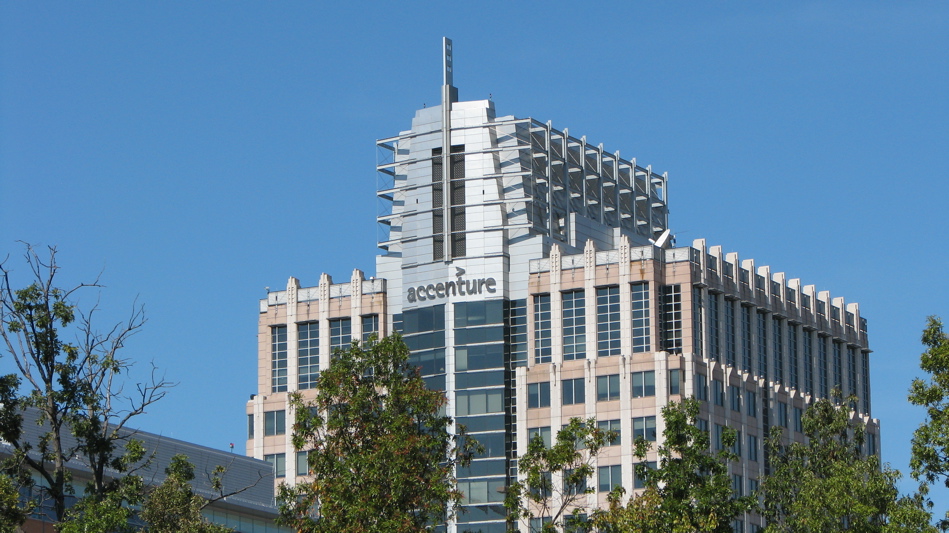
By Tim Shorrock
WASHINGTON, DC – Not long ago, as I was preparing an article on government contracting, I was given a tour of Northern Virginia by a friend who spent over a decade as an intelligence operative and another five years working as an intelligence contractor. We drove through Arlington, Herndon, Fairfax, Tysons Corner and McLean, and up to Dulles Airport. Our route took us from the entrance to the CIA through “contractor alley” and past the huge, gleaming office buildings that house the dozens of corporations that make up what Lt. Gen. James Clapper, the incoming director of the Office of National Intelligence, likes to call “the intelligence enterprise.”
This industrial neighborhood is home to around 60 percent of the Intelligence Community. These are the private sector warriors who staff the offices and installations of the CIA, the National Security Agency, the National Geospatial-Intelligence Agency, and the rest of the so-called “Intelligence Community.” As I first reported in Salon in 2007 and later in my book, SPIES FOR HIRE, 70 percent of our intelligence budget goes to these companies. Officially, according to a 2008 ODNI study of human capital within the IC, nearly 40,000 private contractors are working for intelligence agencies, bringing the total number of IC employees to more than 135,000.
So here, as an introduction to the upcoming Washington Post series on intelligence contractors that has the agencies quaking in their boots, is a guide to the “real” IC (I’m sure the Post isn’t going to credit my work, so here’s my chance – with a little help from fellow muckrakers – to scoop the paper for once: screw ’em).
Enjoy the ride; initial links to company names are to their section of the intelligence database I built with CorpWatch. All photos are copyright Tim Shorrock/2010.
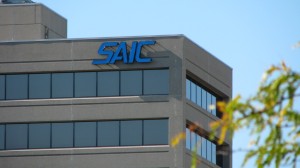
We begin the tour: Ah, yes, SAIC, the Big Daddy of privatized intelligence, the company responsible for the failed $5 billion Trailblazer program at the NSA, which was supposed to keep track of the billions of bits of data downloaded by the NSA around the world but totally failed. SAIC, which recently moved its headquarters from San Diego to this building, stands like a private colossus across the whole intelligence industry. Of its 42,000 employees, more than 20,000 hold U.S. government security clearances, making it, with Lockheed Martin, one of the largest private intelligence services in the world.
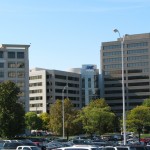
SAIC’s offices stand in this office park, right next to its biggest competitor, Booz Allen Hamilton. Booz is involved in virtually every aspect of the modern intelligence enterprise, from advising top officials on how to integrate the 16 agencies within the Intelligence Community (IC), to detailed analysis of signals intelligence, imagery and other critical collections technologies.
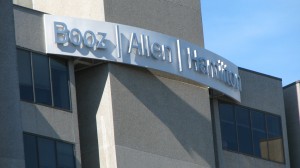
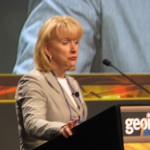
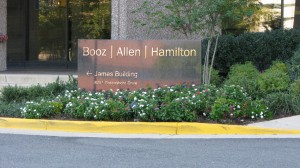
Booz’s strategic role in the IC was best described in 2003 by Joan Dempsey, then the top assistant to CIA Director George Tenet for community management. “I like to call Booz Allen the Shadow IC,” she said when receiving a lifetime achievement award from a contractor group, because it has “more former secretaries of this and directors of that” than the entire government. Dempsey, whose picture is to the right (speaking at a contractor-sponsored event known as GEOINT) is now Booz’s senior vice president, responsible for many of the programs she managed while at the CIA. Booz itself it owned by the Carlyle Group, one of the nation’s most politically-connected private equity funds. Booz is also known for being king of the revolving door at the IC, as personified by former NSA Director Mike McConnell, who left the NSA to become Booz’s top executive on military intelligence, served for most of the Bush administration as DNI, and is now back in his old slot at Booz. So, not surprisingly, security is tight at this building; just after I took this picture, a pair of burly security guards came out and gave me the cold stare. I smiled and promptly left.
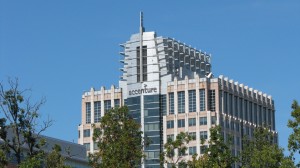
This collosal building, near the SAIC/Booz complex, is the headquarters for Accenture, the global consulting company that was formerly a branch of Andersen Consulting. Few people know (and you certainly wouldn’t pick up from their website) that Accenture is deeply involved in intelligence work. But as I learned at several industry gatherings I attended while researching my book, it does financial planning and audits for the IC and recently began providing information-sharing and collaboration tools to agencies. Its customers, according to Accenture literature I’ve gathered, include the NSA, the Defense Intelligence Agency, the NGA and the National Reconaissance Office.
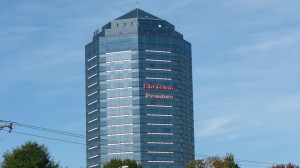
Down the road, visible for several miles, is this Sheraton Hotel. It’s not a contractor building, of course, but it is where the CIA and other agencies like to wine and dine their contractors as well as visiting dignitaries from foreign intelligence agencies such as Britain’s MI5.
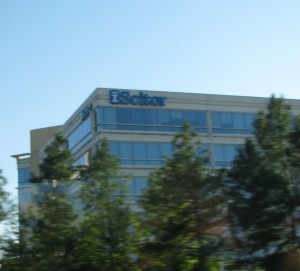
This building behind the trees is the headquarters for Scitor, a virtually unknown company that does over $300 million worth of business with U.S. intelligence every year. Scitor is “the biggest company you never heard of,” a former NSA officer who knows the company well once said (see the company’s profile in my book). It is a technology company that does extensive work for the Air Force in aerospace communications and satellite support services. The privately held company is also an important contractor for the CIA’s Directorate of Science and Technology. Within that directorate, it is used primarily by the Office of Technical Services, the secretive unit that develops the gadgets, weapons, and disguises used by spies. If you can divine anything from its website, you’re probably a spook yourself. So too if you can recognize these companies, whose logos are pointed out by my guide: Juniper, Blackbird Technologies and RavenTech (so many predator metaphors!)
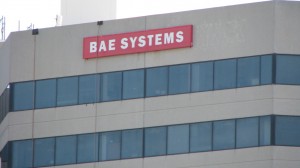
On the other hand, most people recognize BAE Systems, one of the many British companies that have made deep inroads into the U.S. intelligence market. BAE’s intelligence division has extensive operations throughout the DC area and operates numerous Sensitive Compartmented Information Facilities (SCIF) for intelligence agencies. These facilities have special windows that prevent outside infiltration of electronic spying devices. According to BAE, “Our newest facility in Herndon, Virginia, known as the Information Analysis Center (IAC) is a state-of-the-art workspace, built to stringent…customer security, communications, and analytic requirements. This facility, which was opened in July, 2005, provides over 150,000 square feet of accredited SCIF space accommodating over 700 personnel.” BAE provides much of its contracting services (especially to the CIA) through its Global Analysis intelligence unit, which described itself as “a leading provider of skilled, fully cleared, and experienced intelligence and geospatial analysts working directly with Government agencies and U.S. military commands to satisfy regular and surge requirements.” This is no bit player.
Not every building in contractor alley is marked. Only those who know can identify the headquarters of the DNI or the National Counter-Terrorism Center. But it’s easy to figure out which facility in the Herndon-Fairfax corridor is an intelligence center: the intense security just gives it away.
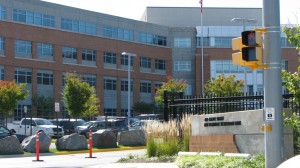
This building is reportedly a special intelligence office; next to it is a small building with a CACI logo on it. That makes the barricaded site even more obvious.
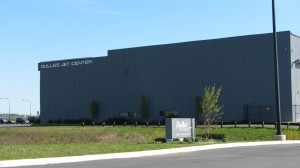
Finally, if you think that Dulles International Airport is just for the public, guess again. Throughout the complex are terminals often used by the CIA to whisk officials, operatives and contractors to their foreign destinations without being seen by ordinary travellers and with heavy security. That’s what this building is; my tour guide said he had used it several times to depart for the Middle East and other spots, both as an intelligence operative and as a contractor. Dual use, you might say, and a metaphor for the entire intelligence enterprise.
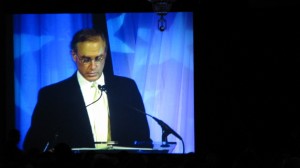
Then of course there’s the industry parties, where the contractors get to spend their money on lavish events of back-slapping and celebration. That’s what’s happening here, where Stan Soloway, the executive director of the Professional Services Council, the voice and chief lobbyist of the contractor industry, is opening the “Academy Awards of the Government Contracting World” at the swank Ritz Carlton Hotel in Tysons Corner.
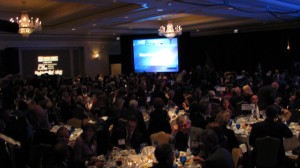
At this event, held every October, the scions of the Washington business community pay tribute to the leading companies in the government contracting industry. Like A-List actors at the Oscars, it’s the high-flying intelligence contractors that usually sweep the awards: at this event, in 2008, the big winner was Booz Allen, which was chosen best contractor of the year for companies earning more than $300 million a year. Booz’s competitors for the top spot were CACI International, which earns much of its money from the CIA, and CSC, another big NSA contractor.“This is the new face of government,” Soloway, a top Pentagon acquisition official during the Clinton administration, later told me about the 350 corporate members of his association. So who elected you? I thought.
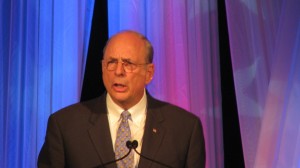
The highlight of the PSC’s gala was the induction of Norman R. Augustine (below), the former chairman and CEO of Lockheed Martin, into the contractor “hall of fame.” Lockheed Martin, largely on the basis of its huge military and intelligence business, is the government’s largest contractor, bringing in close to $17 billion in contracts in 2009 (see the rankings here). “There are fewer greater burdens that one could bear than accepting the fiduciary responsibility of spending the public’s money,” Augustine told the contractors. Ah yes, the new white men’s burden: spying for profit.
So that’s our tour. Enjoy the sites. And enjoy the Dana Priest-Bill Arkin series in the Post. It’s about damn time they covered this story: intelligence outsourcing to this extent has only been a fact of life in Washington since, oh, 2002. The real question to be asked of the Post is: why the hell did it take them eight years?
Note: I was a guest on Democracy Now! with Amy Goodman on July 19, 2010, talking about this article and the Washington Post stories on privatized intelligence.
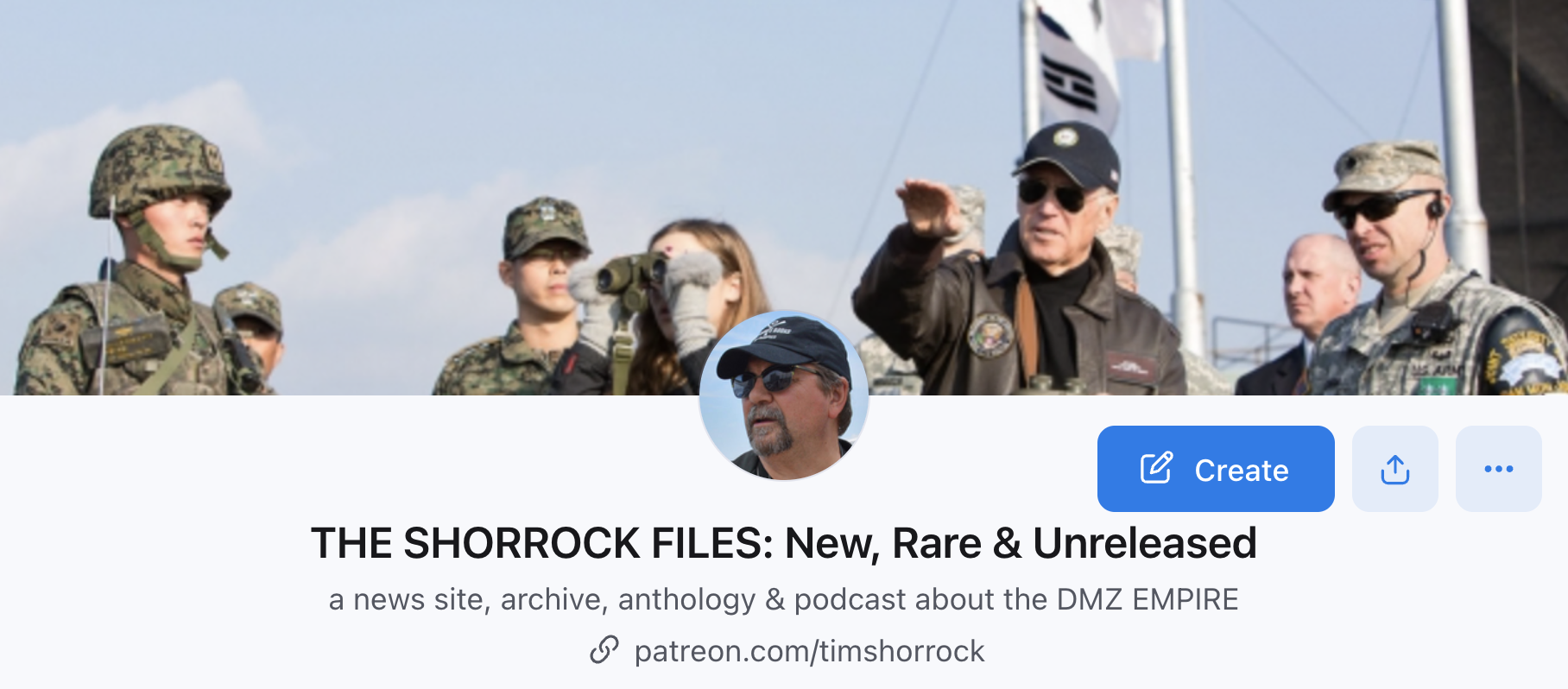
Public benefit vs private profit
Tim,
Just wanted to say, fantastic article. To Hugh – I think the point of the article isn’t that there’s anything wrong with people who have security clearances or companies that do classified work – a portion of work for many technology companies is servicing some government contracts to manufacture product. The real problem that I hope the American public wakes up and realizes is that the companies listed in this article are almost exclusively set up for the sole purpose of conducting work that belongs inside regulated/monitored government agencies. Not long ago I did a piece on In-Q-Tel spying on social networks for the CIA.
What makes this so wrong is that private companies are, by their nature, strongholds for corporate corruption, greed and profit. They do not have the best interests of the American Public in mind – and they should not be reaping corporate profits on our dime…there are family’s starving off food-stamps and you’ve got these corporate fat-cats dining off of the taxes that come out of our meager pay checks. Enough is enough.
[…] sad about this series – at least, the first installment – is how unsurprising it is. Tim Shorrock and others have reported on this trend for years. But even if you were unaware the details that the […]
if Osama ben Laden could see how his actions led to this manifestation…
I saw the interview that you did tonight with Amy Goodman on Democracy Now. I had read the Washington Post first part installment of the four part series “Top Secret America” earlier in the day and think that you are quite correct in your assertion about where the hell has the mainstream media been these past nine years. My own feeling is that Catherine Graham’s daughter sees the writing on the wall and has decided to make the Post more relevant, i.e. actually do what the press should be doing in a democracy-informing the public on the important issues of the day because the Post has lost readership and such a move seems logical. It is a huge untold story how these corporations have expolited 9-11 and the fear factor so cleverly.
Many people think that the primary target of the intelligence community is actually the American people themselves.
Would you agree with this?
I have an uncle who is a retired NSA employee and I had the opportunity to play softball with some of the folks from NSA when I was younger.
Pretty ordinary middle class type people whose jobs have maybe been lost to these contractors.